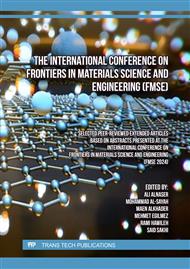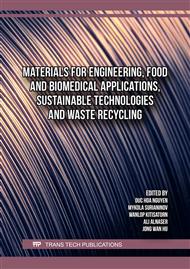[1]
M.Z. Naser, R.A. Hawileh, J.A. Abdalla, Fiber-reinforced polymer composites in strengthening reinforced concrete structures: A critical review, Eng. Struct. 198 (2019).
DOI: 10.1016/j.engstruct.2019.109542
Google Scholar
[2]
L.C. Hollaway, A review of the present and future utilization of FRP composites in the civil infrastructure with reference to their important in-service properties, Constr. Build. Mater. 24 (2010) 2419–2445.
DOI: 10.1016/j.conbuildmat.2010.04.062
Google Scholar
[3]
W. Sun, J.O. Jirsa, W.M. Ghannoum, Behavior of anchored carbon fiber-reinforced polymer strips used for strengthening concrete structures, ACI Mater. J. 113 (2016) 163–172.
DOI: 10.14359/51688637
Google Scholar
[4]
J. Tatar, C. Viniarski, K.A. Harries, M. Head, Effectiveness of U-wrap Anchorage of Flexural CFRP Reinforcement in Strengthened Reinforced Concrete Beams, Lecture Notes in Civil Engineering 198 LNCE (2022) 1305–1316.
DOI: 10.1007/978-3-030-88166-5_113
Google Scholar
[5]
R.A. Hawileh, W. Nawaz, J.A. Abdalla, E.I. Saqan, Effect of flexural CFRP sheets on shear resistance of reinforced concrete beams, Compos. Struct. 122 (2015) 468–476.
DOI: 10.1016/j.compstruct.2014.12.010
Google Scholar
[6]
G.S. Alshami, R.A. Hawileh, J.A. Abdalla, H.H. Mhanna, Evaluation on the effect of anchor embedment depth on the flexural capacity of concrete prisms, Procedia Structural Integrity 37 (2021) 367–374.
DOI: 10.1016/j.prostr.2022.01.097
Google Scholar
[7]
G.S. Alshami, R.A. Hawileh, F. Asce, J. Tatar, M. Asce, J.A. Abdalla, Influence of CFRP Spike Anchors on the Performance of Flexural CFRP Sheets Externally Bonded to Concrete, Journal of Composites for Construction 27 (2023).
DOI: 10.1061/JCCOF2.CCENG-4182
Google Scholar
[8]
A.T. Al-Sammari, S.F. Breña, Strength of Carbon Fiber-Reinforced Polymer (CFRP) sheets bonded to concrete with CFRP spike anchors, ACI Struct. J. 118 (2021) 153–166.
DOI: 10.14359/51728084
Google Scholar
[9]
T. Ozbakkaloglu, C. Fang, A. Gholampour, Influence of FRP anchor configuration on the behavior of FRP plates externally bonded on concrete members, Eng. Struct. 133 (2017) 133–150.
DOI: 10.1016/j.engstruct.2016.12.005
Google Scholar
[10]
R.A. Hawileh, M. Assad, J.A. Abdalla, Effect of increasing the number of anchors on the flexural performance of FRP-strengthened RC beams, Procedia Structural Integrity 54 (2024) 287–293.
DOI: 10.1016/j.prostr.2024.01.085
Google Scholar
[11]
M. Assad, R.A. Hawileh, J.A. Abdalla, Flexural strengthening of reinforced concrete beams with CFRP laminates and spike anchors, Composites Part C: Open Access 13 (2024).
DOI: 10.1016/j.jcomc.2024.100443
Google Scholar
[12]
R.A. Hawileh, H.A. Rasheed, J.A. Abdalla, A.K. Al-Tamimi, Behavior of reinforced concrete beams strengthened with externally bonded hybrid fiber reinforced polymer systems, Mater. Des. 53 (2014) 972–982.
DOI: 10.1016/j.matdes.2013.07.087
Google Scholar
[13]
I.A. Cortez Flores, J. Fernández Gómez, P. Villanueva Llauradó, Influence of multiple anchor arrangement in the behaviour of FRP-to-concrete anchored joints, Compos. Struct. 230 (2019).
DOI: 10.1016/j.compstruct.2019.111528
Google Scholar
[14]
K. Nakaba, T. Kanakubo, T. Furuta, H. Yoshizawa, Bond Behavior between Fiber-Reinforced Polymer Laminates and Concrete, 2001.
DOI: 10.1142/9789812704863_0010
Google Scholar
[15]
C. Pellegrino, D. Tinazzi, C. Modena, Experimental Study on Bond Behavior between Concrete and FRP Reinforcement.
Google Scholar
[16]
B. Ferracuti, M. Savoia, C. Mazzotti, Interface law for FRP-concrete delamination, Compos. Struct. 80 (2007) 523–531.
DOI: 10.1016/j.compstruct.2006.07.001
Google Scholar
[17]
F.C. An, F.Y. Zhang, C.C. Hou, Influence of mechanical properties of concrete on the failure behaviour of FRP-to-concrete interface, Constr. Build. Mater. 264 (2020).
DOI: 10.1016/j.conbuildmat.2020.120572
Google Scholar
[18]
H. Toutanji, G. Ortiz, The effect of surface preparation on the bond interface between FRP sheets and concrete members, Compos Struct 53 (2001) 457–462.
DOI: 10.1016/S0263-8223(01)00057-5
Google Scholar
[19]
C. Chen, X. Li, D. Zhao, Z. Huang, L. Sui, F. Xing, Y. Zhou, Mechanism of surface preparation on FRP-Concrete bond performance: A quantitative study, Compos. B Eng. 163 (2019) 193–206.
DOI: 10.1016/J.COMPOSITESB.2018.11.027
Google Scholar
[20]
M.R. Garcez, A.B. Rohden, L.C. Meneghetti, R. Gravina, Influence of concrete compressive strength on the debonding failure of externally bonded carbon fiber reinforced polymers, Journal of Building Pathology and Rehabilitation 6 (2021) 1–15.
DOI: 10.1007/s41024-021-00116-3
Google Scholar
[21]
J.W. Shi, W.H. Cao, Z.S. Wu, Effect of adhesive properties on the bond behavior of externally bonded FRP-to-concrete joints, Compos. B Eng. 177 (2019) 107365.
DOI: 10.1016/J.COMPOSITESB.2019.107365
Google Scholar
[22]
C. Pellegrino, D. Tinazzi, C. Modena, Experimental Study on Bond Behavior between Concrete and FRP Reinforcement, Journal of Composites for Construction 12 (2008) 180–189.
DOI: 10.1061/(asce)1090-0268(2008)12:2(180)
Google Scholar
[23]
K. Nakaba, T. Kanakubo, T. Furuta, H. Yoshizawa, Bond Behavior between Fiber-Reinforced Polymer Laminates and Concrete, ACI Struct. J. 98 (2001).
DOI: 10.14359/10224
Google Scholar
[24]
B. Ferracuti, M. Savoia, C. Mazzotti, Interface law for FRP-concrete delamination, Compos. Struct 80 (2007) 523–531.
DOI: 10.1016/j.compstruct.2006.07.001
Google Scholar
[25]
P. Athawale, S. Morse, X. Chen, P.G. Miller, Analysis of Factors Affecting Effective Bond Length for Fiber Reinforced Polymer Composite Laminate Externally Bonded to Concrete Substrate, Texas Tech University, 2012.
Google Scholar
[26]
ASTM C 109 C109M-16a | PDF | Cement | Concrete. https://www.scribd.com/ document/585804859/ASTM-C-109-C109M-16a (accessed April 21, 2024).
Google Scholar
[27]
MAPEI 2016, MapeWrap C UNI-AX 300, High Strength Uni-Directional Carbon Fiber Fabric with High Modulus of Elasticity -Technical Specification Sheet,1–6.
Google Scholar
[28]
MAPEI 2019b, Mape Wrap 31, Medium Viscosity Epoxy Resin for Impregnation of MapeWrap with "Dry System" - Technical Specification Sheet,1–5.
Google Scholar
[29]
MAPEI 2019a, Mape Wrap Primer 1, Epoxy Primer Specific for MapeWrap System - Technical Sheet,1–4.
Google Scholar
[30]
ACI Committee 440, ACI 440.9R-15-Guide to Accelerated Conditioning Protocols for Durability Assessment of Internal and External Fiber-reinforced Polymer (FRP) Reinforcement, 2015.
Google Scholar
[31]
ASTM C 1609, ASTM C1609 Standard test method for flexural performance of fiber-reinforced concrete, 2010.
Google Scholar



